Effect of Quartz Nano-Particles on the Performance Characteristics of Asphalt Mixture
Abstract
:1. Introduction
2. Materials
2.1. Bitumen
2.2. Aggregates
2.3. Quartz Nano-Particles
2.4. Sample Preparation
| Sr. No | Author | Materials | Mixing Temperature | Mixing Speed |
|---|---|---|---|---|
| 1 | Metwally et al. [29] | QNPs (3, 5, 7, 9, and 11%) | 150 °C | Mixed until homogeneity achieved |
| 2 | Zalnezhad et al. [11] | Sasobit (2% wt.), QNPs (2–6% wt.) | 180 °C | Not specified |
| 3 | Tanzadeh and Shahrezagamasae [31] | QNPs, Polymer SBS (4.5%), Polypropylene Fiber (0.3%), Lime Powder (0.5 and 1%), Glass Fiber (0.1% and 0.2%) | 160 °C | 1800 rpm for 20 min |
| 4 | Galooyak et al. [44] | Sasobit (2% wt.), QNPs (2–6% wt.) | 180 °C | 3000 rpm for 30 min |
| 5 | (Ezzat et al., 2018) [41] | QNPs (3, 5, and 7% by weight) and nano-montmorillonite | 145 °C | 1500 rpm for 1 h |
| 6 | Enieb and Diab [3] | QNPs (2, 4 and 6 wt.%) | 160 °C | 2000 rpm for 1 h |
| 7 | (Crucho et al., 2018) [33] | QNPs, nano-iron, nano-clay bentonite | 160 °C | 2000 rpm for 1 h |
| 8 | Taherkhani and Afroozi [43] | QNPs (1, 3, and 5% by wt. of bitumen) | 160 °C | 3000 rpm for 1 h |
| 9 | Hassan Taherkhani and Siamark Afroozi [26] | QNPs (1, 3, and 5% wt.) | 160 °C | 3000 rpm for 1 h |
| 10 | (Taherkhani and Afroozi, 2017) [42] | QNPs (1, 3, and 5% wt.) | 160 °C | 3000 rpm for 1 h |
| 11 | Alhamali et al. [45] | QNPs (0, 2, 4, and 6% wt.) | 163 °C | 3000 rpm for 1 h |
| 12 | Ganjei and Aflaki [46] | Bitumen, QNPs (0, 0.5, 1, and 2%) and SBS Polymers (0, 1, 3, and 5%) | 170 °C | Ultrasonic high shear mixer for one hour |
| 13 | Amin and Esmail [47] | QNPs (0.5, 1, 1.5, and 2% by wt. of bitumen) | 120 °C | 3600 rpm for 1 h |
| 14 | Bala et al. [48] | Linear Low-Density Polyethylene (LLDPE 6%), QNPs (1, 2, and 3%) | 150 °C | 4000 rpm for 2 h |
2.5. Preparation of Asphalt Mixtures
3. Tests Performed
3.1. Scanning Electron Microscopy
3.2. Storage Stability
3.3. Fourier Transform Infrared Spectroscopy
3.4. Traditional Bitumen Tests
3.5. Frequency Sweep Test
3.6. Bitumen Bond Strength
3.7. Cooper Wheel Tracker Test (CWTT)
4. Results and Discussion
4.1. Dispersion of QNPs into the Base Bitumen
4.2. Effect of QNPs on Storage Stability of Base Bitumen
4.3. Fourier Transform Infrared Spectroscopy
4.4. Conventional Bitumen Test Results
4.5. Frequency Sweep Test
4.6. Influence of QNPs on Performance Grading (PG)
4.7. Bitumen Bond Strength Test
4.8. Effect of QNPs on Rut Depth
5. Conclusions
- SEM images confirm that the adopted laboratory mixing methodology via homogenizer is an effective method for the successful dispersion of QNPs into bitumen. Further, recorded storage stability test values of QNP-modified bitumen were less than 2.2 °C, i.e., which also ensures the permanence of the dispersion of QNPs in the bitumen. This confirms that QNP-modified bitumen is a stable product and can be adopted by the local pavement construction industry;
- The FTIR results confirmed that the dispersion of QNPs into the base bitumen was purely a physical mixing process. The peaks of each modified sample were similar to the base bitumen, which indicates that the adopted mixing protocol was acceptable for the preparation of a stable product;
- The introduction of QNPs into the bitumen enhanced the conventional physical characteristics of the asphalt bitumen due to its large surface area and high dispersion. The 5% QNP-modified bitumen reduced penetration and ductility values by 48% and 63%, respectively, representing an improvement in the stiffness values. Further, the 18% increase in the softening point value of 5% QNP-modified bitumen indicates lower temperature sensitivity and thermal susceptibility. Lowering the temperature sensitivity of bitumen results in the enhancement of its resistance against permanent deformation and low-temperature cracking;
- DSR results concluded that the addition of quartz nano-particles enhanced asphalt’s viscoelastic properties and rut resistance at high temperatures. DSR rut resistance criteria showed that 5% QNP bitumen was optimally modified, just as the BBS result favored the 5% QNP-modified bitumen. Hence, SEM and FTIR results suggested that 5% QNPs could be selected as the optimum modification percentage for economic modification. Moreover, 5% QNPs-modified bitumen satisfied the rutting resistance super-pave design criteria (G*sinδ > 1 kPa) for higher temperatures, i.e., 70 °C;
- BBS results showed that the introduction of QNPs into the base bitumen significantly improved the cohesive and adhesive bond strength in both 24 h dry and 24 h wet conditions and reduced the moisture susceptibility of the base bitumen. Incorporating 5% QNPs into the base bitumen enhanced the BBS value by 56% and 50% in dry and wet conditions. Thus, based on wet condition results, it was confirmed that 5% QNPs prominently improved the moisture sensitivity and durability of asphalt;
- The CWTT performed on QNP-modified (1%, 3% and 5%) asphalt provided evidence of lower rut depth, i.e., 27%, 35%, and 40%, respectively, at 55 °C. This shows the consistent results attained from the DSR that the 5% QNP dosage has the highest resistance to permanent deformation at high temperatures among all the samples.
Author Contributions
Funding
Institutional Review Board Statement
Informed Consent Statement
Data Availability Statement
Acknowledgments
Conflicts of Interest
References
- Rafi, J.; Kamal, M.; Ahmad, N.; Hafeez, M.; Faizan ul Haq, M.; Aamara Asif, S.; Shabbir, F.; Bilal Ahmed Zaidi, S. Performance Evaluation of Carbon Black Nano-Particle Reinforced Asphalt Mixture. Appl. Sci. 2018, 8, 1114. [Google Scholar] [CrossRef] [Green Version]
- Cheraghian, G.; Wang, D.; Kim, Y.S.; Wistuba, M.P. Experimental Investigation on Ultraviolet Aging Properties of Silica Nanoparticles-Modified Bitumen. In Proceedings of the RILEM International Symposium on Bituminous Materials, Lyon, France, 14–16 December 2020; pp. 879–885. [Google Scholar]
- Enieb, M.; Diab, A. Characteristics of asphalt binder and mixture containing nanosilica. Int. J. Pavement Res. Technol. 2017, 10, 148–157. [Google Scholar] [CrossRef]
- Putman, B.J.; Amirkhanian, S.N. Utilization of waste fibers in stone matrix asphalt mixtures. Resour. Conserv. Recycl. 2004, 42, 265–274. [Google Scholar] [CrossRef]
- Anurag, K.; Xiao, F.; Amirkhanian, S.N. Laboratory investigation of indirect tensile strength using roofing polyester waste fibers in hot mix asphalt. Constr. Build. Mater. 2009, 23, 2035–2040. [Google Scholar] [CrossRef]
- Xiao, F.; Amirkhanian, S.N.; Shen, J.; Putman, B. Influences of crumb rubber size and type on reclaimed asphalt pavement (RAP) mixtures. Constr. Build. Mater. 2009, 23, 1028–1034. [Google Scholar] [CrossRef]
- Shen, J.; Amirkhanian, S.; Xiao, F.; Tang, B. Influence of surface area and size of crumb rubber on high temperature properties of crumb rubber modified binders. Constr. Build. Mater. 2009, 23, 304–310. [Google Scholar] [CrossRef]
- Mann, S. Nanoforum Report: Nanotechnology and Construction; Institute of Nanotechnology: Karlsruhe, Germany, 2006. [Google Scholar]
- Kelsall, R.W.; Hamley, I.W.; Geoghegan, M. Nanoscale Science and Technology; John Wiley & Sons: Chichester, UK, 2005; ISBN 9780470850862. [Google Scholar]
- Federal Highway Administration. Nano-scale Approaches for Highway Research; Exploratory Advanced Research Program; Federal Highway Administration: Washington, DC, USA, 2010; 8p. [Google Scholar]
- Zalnezhad, H.; Galooyak, S.S.; Farahani, H.; Goli, A.; Technology, R.; Division, D. Investigating the Effect of Nano-silica on the Specification of the Sasobit Warm Mix Asphalt. Pet. Coal 2015, 57, 509–515. [Google Scholar]
- Yang, J.; Tighe, S. A Review of Advances of Nanotechnology in Asphalt Mixtures. Proc. Soc. Behav. Sci. 2013, 96, 1269–1276. [Google Scholar] [CrossRef] [Green Version]
- Bhargava, S.; Raghuwanshi, A.K.; Gupta, P. Nanomaterial Compatibility and Effect on Properties of Base Bitumen Binder and Polymer Modified Bitumen Nanomaterial Compatibility and Effect on Properties of Base Bitumen Binder and Polymer Modified Bitumen. Int. J. Innov. Sci. Eng. Technol. 2016, 3, 276–282. [Google Scholar]
- Steyn, W.J. Applications of Nanotechnology in Road Pavement Engineering. In Nanotechnology in Civil Infrastructure; Springer: Berlin, Germany, 2011; pp. 49–83. [Google Scholar]
- Yao, H.; You, Z. Effectiveness of Micro-and Nanomaterials in Asphalt Mixtures through Dynamic Modulus and Rutting Tests. J. Nanomater. 2016, 2016, 10. [Google Scholar] [CrossRef] [Green Version]
- Yusak, M.I.M.; Abdullah, M.E.; Jaya, R.P.; Hainin, M.R.; Ibrahim, M.H.W. Effect of Nano Silica on the Physical Property of Porous Concrete Pavement. IOP Conf. Ser. Mater. Sci. Eng. 2017, 226, 012043. [Google Scholar] [CrossRef] [Green Version]
- Zheng, X.; Wilkie, C.A. Flame retardancy of polystyrene nanocomposites based on an oligomeric organically-modified clay containing phosphate. Polym. Degrad. Stab. 2003, 81, 539–550. [Google Scholar] [CrossRef] [Green Version]
- Simon, M.W.; Stafford, K.T.; Ou, D.L. Nanoclay reinforcement of liquid silicone rubber. J. Inorg. Organomet. Polym. Mater. 2008, 18, 364–373. [Google Scholar] [CrossRef]
- Yang, Z.; Hollar, J.; Shi, X. Surface-sulfonated polystyrene microspheres improve crack resistance of carbon microfiber-reinforced Portland cement mortar. J. Mater. Sci. 2010, 45, 3497–3505. [Google Scholar] [CrossRef]
- Zhou, X.X.; Zhang, G.F.; Liu, R.M.; Zheng, L. Molecular Simulations of Anti-Aging Mechanisms on Nano-LDHs Modified Asphalt. Key Eng. Mater. 2014, 599, 198–202. [Google Scholar]
- Veytskin, Y.; Bobko, C.; Castorena, C. Nanoindentation investigation of asphalt binder and mastic viscoelasticity. Int. J. Pavement Eng. 2016, 17, 363–376. [Google Scholar] [CrossRef]
- Yusoff, N.I.M.; Breem, A.A.S.; Alattug, H.N.M.; Hamim, A.; Ahmad, J. The effects of moisture susceptibility and ageing conditions on nano-silica/polymer-modified asphalt mixtures. Constr. Build. Mater. 2014, 72, 139–147. [Google Scholar] [CrossRef]
- Yao, H.; You, Z.; Li, L.; Goh, S.W.; Dedene, C. Evaluation of the Master Curves for Complex Shear Modulus for Nano-Modified Asphalt Binders. CICTP 2012, 2012, 3399–3414. [Google Scholar]
- Kong, D.; Du, X.; Wei, S.; Zhang, H.; Yang, Y.; Shah, S.P. Influence of nano-silica agglomeration on microstructure and properties of the hardened cement-based materials. Constr. Build. Mater. 2012, 37, 707–715. [Google Scholar] [CrossRef]
- Lazzara, G.; Milioto, S. Dispersions of nanosilica in biocompatible copolymers. Polym. Degrad. Stab. 2010, 95, 610–617. [Google Scholar] [CrossRef]
- Taherkhani, H.; Afroozi, S. Investigating the creep properties of asphaltic concrete containing nano-silica. Sadhana Acad. Proc. Eng. Sci. 2018, 43, 24. [Google Scholar] [CrossRef] [Green Version]
- Hassan, A.F.; Abdelghny, A.M.; Elhadidy, H.; Youssef, A.M. Synthesis and characterization of high surface area nanosilica from rice husk ash by surfactant-free sol-gel method. J. Sol. Gel Sci. Technol. 2014, 69, 465–472. [Google Scholar] [CrossRef]
- Okamoto, M. Polymer/layered silicate nano-composites structure development and processing operations. Int. Polym. Processing 2006, 21, 487–496. [Google Scholar] [CrossRef]
- Metwally, G.A.-T.; Hassanin, H.D.; Elgendy, M.F.; Sawan, A.M. Improving the Performance of Asphalt Mixtures Using Nano Silica. World Appl. Sci. J. 2017, 35, 2614–2621. [Google Scholar]
- Bhat, F.S.; Mir, M.S. Performance evaluation of nanosilica-modified asphalt binder. Innov. Infrastruct. Solut. 2019, 4, 1–10. [Google Scholar] [CrossRef]
- Tanzadeh, J.; Shahrezagamasaei, R. Laboratory Assessment of Hybrid Fiber and Nano-silica on Reinforced Porous Asphalt Mixtures. Constr. Build. Mater. 2017, 144, 260–270. [Google Scholar] [CrossRef]
- Ghasemi, M.; Morteza Marandi, S.; Tahmooresi, M.; Jalal kamali, R.; Taherzade, R. Modification of Stone Matrix Asphalt with Nano-SiO2. J. Basic Appl. Sci. Res. 2012, 2, 1338–1344. [Google Scholar]
- Crucho, J.M.L.; das Neves, J.M.C.; Capitão, S.D.; Picado-Santos, L.G. de Mechanical performance of asphalt concrete modified with nanoparticles: Nanosilica, zero-valent iron and nanoclay. Constr. Build. Mater. 2018, 181, 309–318. [Google Scholar] [CrossRef]
- Caputo, P.; Porto, M.; Angelico, R.; Loise, V.; Calandra, P.; Oliviero Rossi, C. Bitumen and asphalt concrete modified by nanometer-sized particles: Basic concepts, the state of the art and future perspectives of the nano-scale approach. Adv. Colloid Interface Sci. 2020, 285, 102283. [Google Scholar] [CrossRef]
- Mirza, M.W.; Abbas, Z.; Rizvi, M.A. Temperature Zoning of Pakistan for Asphalt Mix Design. Pak. J. Eng. Appl. Sci. 2011, 8, 49–60. [Google Scholar]
- Aman, A.; Hafeez, I.; Zubair, M.; Zaidi, S.B.A. Influence of phosphorous methyl compound on asphalt binder. Int. J. Pavement Eng. 2020, 22, 1–15. [Google Scholar] [CrossRef]
- Read, J.; Whiteoak, D. The Shell Bitumen Handbook, 5th ed.; Thomas Telford Publishing: London, UK, 2003; ISBN 072773220X. [Google Scholar]
- Haider, S.; Hafeez, I.; Bilal Ahmed Zaidi, S.; Ali Nasir, M.; Rizwan, M. A pure case study on moisture sensitivity assessment using tests on both loose and compacted asphalt mixture. Constr. Build. Mater. 2020, 239, 117817. [Google Scholar] [CrossRef]
- Haider, S.; Hafeez, I.; Jamal; Ullah, R. Sustainable use of waste plastic modifiers to strengthen the adhesion properties of asphalt mixtures. Constr. Build. Mater. 2020, 235, 117496. [Google Scholar] [CrossRef]
- Hussan, S.; Kamal, M.A.; Hafeez, I.; Ahmad, N.; Khanzada, S.; Ahmed, S. Modelling asphalt pavement analyzer rut depth using different statistical techniques. Road Mater. Pavement Des. 2018, 21, 1–26. [Google Scholar] [CrossRef]
- Ezzat, H.; El-Badawy, S.; Gabr, A.; Zaki, S.; Breakah, T. Predicted performance of hot mix asphalt modified with nano-montmorillonite and nano-silicon dioxide based on Egyptian conditions. Int. J. Pavement Eng. 2018, 21, 117–142. [Google Scholar] [CrossRef]
- Taherkhani, H.; Afroozi, S. Investigating the Performance Characteristics of Asphaltic Concrete Containing Nano-Silica. Civ. Eng. Infrastruct. J. 2017, 50, 75–93. [Google Scholar]
- Taherkhani, H.; Afroozi, S. The properties of nanosilica-modified asphalt cement. Pet. Sci. Technol. 2016, 34, 1381–1386. [Google Scholar] [CrossRef]
- Galooyak, S.S.; Palassi, M.; Goli, A.; Farahani, H.Z. Performance Evaluation of Nano-silica Modified Bitumen. Int. J. Transp. Eng. 2015, 3, 55–66. [Google Scholar]
- Alhamali, D.I.; Wu, J.; Liu, Q.; Hassan, N.A.; Yusoff, N.I.M.; Ali, S.I.A. Physical and Rheological Characteristics of Polymer Modified Bitumen with Nanosilica Particles. Arab. J. Sci. Eng. 2015, 41, 1521–1530. [Google Scholar] [CrossRef]
- Ganjei, M.A.; Aflaki, E. Application of nano-silica and styrene-butadiene-styrene to improve asphalt mixture self healing. Int. J. Pavement Eng. 2016, 8436, 1–11. [Google Scholar] [CrossRef]
- Amin, G.M.; Esmail, A. Application of nano silica to improve self-healing of asphalt mixes. J. Cent. South Univ. 2017, 24, 1019–1026. [Google Scholar] [CrossRef]
- Bala, N.; Kamaruddin, I.; Napiah, M.; Danlami, N. Rheological and rutting evaluation of composite nanosilica/polyethylene modified bitumen. In Proceedings of the 7th International Conference on Key Engineering Materials (ICKEM 2017), IOP, Penang, Malaysia, 11–13 March 2017; pp. 2–6. [Google Scholar]
- National Highway Authority. Government of Pakistan, Ministry of Communications, General Specifications; Sampak International Pvt Ltd, Engineering Design Supervision and Management Consultants: Lahore, Pakistan, 1998. [Google Scholar]
- The Asphalt Institute. Mix Design Methods for Asphalt Concrete and Other Hot Mix Types, MS—2; The Asphalt Institute: Lexington, KY, USA, 1984. [Google Scholar]
- Huang, B.; Shu, X.; Chen, X. Effects of mineral fillers on hot-mix asphalt laboratory-measured properties. Int. J. Pavement Eng. 2007, 8, 1–9. [Google Scholar] [CrossRef]
- Faizan, M.; Ahmad, N.; Nasir, M.A.; Jamal; Hafeez, M.; Rafi, J.; Bilal Ahmed Zaidi, S.; Haroon, W. Carbon Nanotubes (CNTs) in Asphalt Binder: Homogeneous Dispersion and Performance Enhancement. Appl. Sci. 2018, 8, 1–19. [Google Scholar]
- Ali, S.I.A.; Ismail, A.; Karim, M.R.; Yusoff, N.I.M.; Al-Mansob, R.A.; Aburkaba, E. Performance evaluation of Al2O3 nanoparticle-modified asphalt binder. Road Mater. Pavement Des. 2017, 18, 1251–1268. [Google Scholar] [CrossRef]
- ASTM. D 5 Standard Test Method for Penetration of Bituminous Materials; Annual Book of ASTM Standards; ASTM: West Conshohocken, PA, USA, 1997; pp. 1–3. [Google Scholar]
- ASTM. D 36 Standard Test Method for Softening Point of Bitumen (Ring and Ball Apparatus); Annual Book of ASTM Standards; ASTM: West Conshohocken, PA, USA, 2000; pp. 8–11. [Google Scholar]
- ASTM. D 92 Standard Test Method for Flash and Fire Points by Cleveland Open Cup Tester; Annual Book of ASTM Standards; ASTM: West Conshohocken, PA, USA, 2007; pp. 1–10. [Google Scholar]
- ASTM. D 113 Standard Test Method for Ductility of Bituminous Materials; Annual Book of ASTM Standards; ASTM: West Conshohocken, PA, USA, 1999; pp. 25–27. [Google Scholar]
- Hafeez, I.; Hussain, J.; Riaz, K.; Khitab, A.; Hussain, S.; Zaidi, B.; Farooqi, U.; Hayat, A.; Ahmed, I.; Asif, A. Influence of time and temperature on asphalt binders rheological properties. Life Sci. J. 2013, 10, 894–898. [Google Scholar]
- AASHTO. T 315-10 Determining the Rheological Properties of Asphalt Binder Using a Dynamic Shear Rheometer (DSR); AASHTO: Washington, DC, USA, 2010. [Google Scholar]
- Canestrari, F.; Cardone, F.; Graziani, A.; Santagata, F.A.; Bahia, H.U. Adhesive and cohesive properties of asphalt-aggregate systems subjected to moisture damage. Road Mater. Pavement Des. 2010, 11, 11–32. [Google Scholar] [CrossRef]
- Behiry, A.E.A.E.M. Laboratory evaluation of resistance to moisture damage in asphalt mixtures. Ain Shams Eng. J. 2013, 4, 351–363. [Google Scholar] [CrossRef] [Green Version]
- ASTM International. D 4541-17, A. D4541-17: Standard Test Method for Pull-Off Strength of Coatings Using Portable Adhesion; ASTM International: West Conshohocken, PA, USA, 2014; pp. 1–16. [Google Scholar]
- Ali, A.; Ahmad, N.; Adeel, M.; Bilal Ahmed Zaidi, S.; Jameel, M.S.; Qureshi, F.A.; Haroon, W.; Asif, S.A. Performance Evaluation of Bone Glue Modified Asphalt. Adv. Mater. Sci. Eng. 2019, 2019, 13. [Google Scholar] [CrossRef] [Green Version]
- Jamal; Hafeez, I.; Yaseen, G.; Aziz, A. Influence of Cereclor on the performance of aged asphalt binder. Int. J. Pavement Eng. 2020, 21, 1309–1320. [Google Scholar] [CrossRef]
- Abdullah, M.E.; Zamhari, K.A.; Nayan, N.; Hainin, M.R.; Hermadi, M. Storage Stability and Physical Properties of Asphalt Modified with Nanoclay and Warm Mix Asphalt Additives. World J. Eng. 2011, 2, 3–4. [Google Scholar]
- Hussein, A.A.; Jaya, R.P.; Abdul Hassan, N.; Yaacob, H.; Huseien, G.F.; Ibrahim, M.H.W. Performance of nanoceramic powder on the chemical and physical properties of bitumen. Constr. Build. Mater. 2017, 156, 496–505. [Google Scholar] [CrossRef]
- Loise, V.; Calandra, P.; Abe, A.A.; Porto, M.; Oliviero Rossi, C.; Davoli, M.; Caputo, P. Additives on aged bitumens: What probe to distinguish between rejuvenating and fluxing effects? J. Mol. Liq. 2021, 339, 116742. [Google Scholar] [CrossRef]
- Ba-Abbad, M.M.; Chai, P.V.; Takriff, M.S.; Benamor, A.; Mohammad, A.W. Optimization of nickel oxide nanoparticle synthesis through the sol-gel method using Box-Behnken design. Mater. Des. 2015, 86, 948–956. [Google Scholar] [CrossRef]
- Karnati, S.R.; Oldham, D.; Fini, E.H.; Zhang, L. Surface functionalization of silica nanoparticles to enhance aging resistance of asphalt binder. Constr. Build. Mater. 2019, 211, 1065–1072. [Google Scholar] [CrossRef]
- Leiva-Villacorta, F.; Vargas-Nordcbeck, A. Optimum content of nano-silica to ensure proper performance of an asphalt binder. Road Mater. Pavement Des. 2019, 20, 414–425. [Google Scholar] [CrossRef]
- Yao, H.; You, Z.; Li, L.; Lee, C.H.; Wingard, D.; Yap, Y.K.; Shi, X.; Goh, S.W. Rheological Properties and Chemical Bonding of Asphalt Modified with Nanosilica. J. Mater. Civ. Eng. 2013, 25, 1619–1630. [Google Scholar] [CrossRef] [Green Version]
- Hofko, B.; Alavi, M.Z.; Grothe, H.; Jones, D.; Harvey, J. Repeatability and sensitivity of FTIR ATR spectral analysis methods for bituminous binders. Mater. Struct. Mater. Constr. 2017, 50, 1–15. [Google Scholar] [CrossRef] [Green Version]
- IR Spectra. Available online: https://chem.libretexts.org/@go/page/213355 (accessed on 23 April 2020).
- Liu, X. IR Spectrum and Characteristic Absorption Bands. In Organic Chemistry I; Kwantlen Polytechnic University: Surrey, BC, Canada, 2021; ISBN 978-1-989864-52-4. [Google Scholar]
- Mostafa, A.E.A. Examining the Performance of Hot Mix Asphalt Using Nano- Materials. IOSR J. Eng. (IOSRJEN) 2016, 6, 25–34. [Google Scholar]
- Felode, O.; Jonathan, G.; Ohinola, O. Softening point and Penetration Index of bitumen from parts of Southwestern Nigeria. Nafta 2012, 63, 319–323. [Google Scholar]
- Al-Omari, A.A.; Khedaywi, T.S.; Khasawneh, M.A. Laboratory characterization of asphalt binders modified with waste vegetable oil using SuperPave specifications. Int. J. Pavement Res. Technol. 2018, 11, 68–76. [Google Scholar] [CrossRef]
- Airey, G.D. Use of Black Diagrams to Identify Inconsistencies in Rheological Data. Road Mater. Pavement Des. 2002, 3, 403–424. [Google Scholar] [CrossRef]
- Airey, G.D.; Rahimzadeh, B.; Collop, A.C. Linear Viscoelastic Limits of Bituminous Binders. In Proceedings of the Asphalt Paving Technology 2002, Colorado Springs, CO, USA, 18–20 March 2002; Volume 71. [Google Scholar]
- Bahia, H.; Moraes, R.; Velasquez, R. the Effect of Bitumen Stiffness on the Adhesive Strength Measured By the Bitumen Bond Strength Test. In Proceedings of the 5th Eurasphalt and Eurobitume Congress, Istanbul, Turkey, 13–15 June 2012. [Google Scholar]
- Moraes, R.; Velasquez, R.; Bahia, H.U. Measuring the Effect of Moisture on Asphalt–Aggregate Bond with the Bitumen Bond Strength Test. Transp. Res. Rec. J. Transp. Res. Board 2011, 2209, 70–81. [Google Scholar] [CrossRef] [Green Version]
- Valadares, L.F.; Linares, E.M.; Bragança, F.C.; Galembeck, F. Electrostatic adhesion of nanosized particles: The cohesive role of water. J. Phys. Chem. C 2008, 112, 8534–8544. [Google Scholar] [CrossRef]
- Mirković, K.; Tošić, N.; Mladenović, G. Effect of Different Types of Fly Ash on Properties of Asphalt Mixtures. Adv. Civ. Eng. 2019, 2019, 8107264. [Google Scholar] [CrossRef]
- Chelovian, A.; Shafabakhsh, G. Laboratory evaluation of Nano Al2O3 effect on dynamic performance of stone mastic asphalt. Int. J. Pavement Res. Technol. 2017, 10, 131–138. [Google Scholar] [CrossRef] [Green Version]
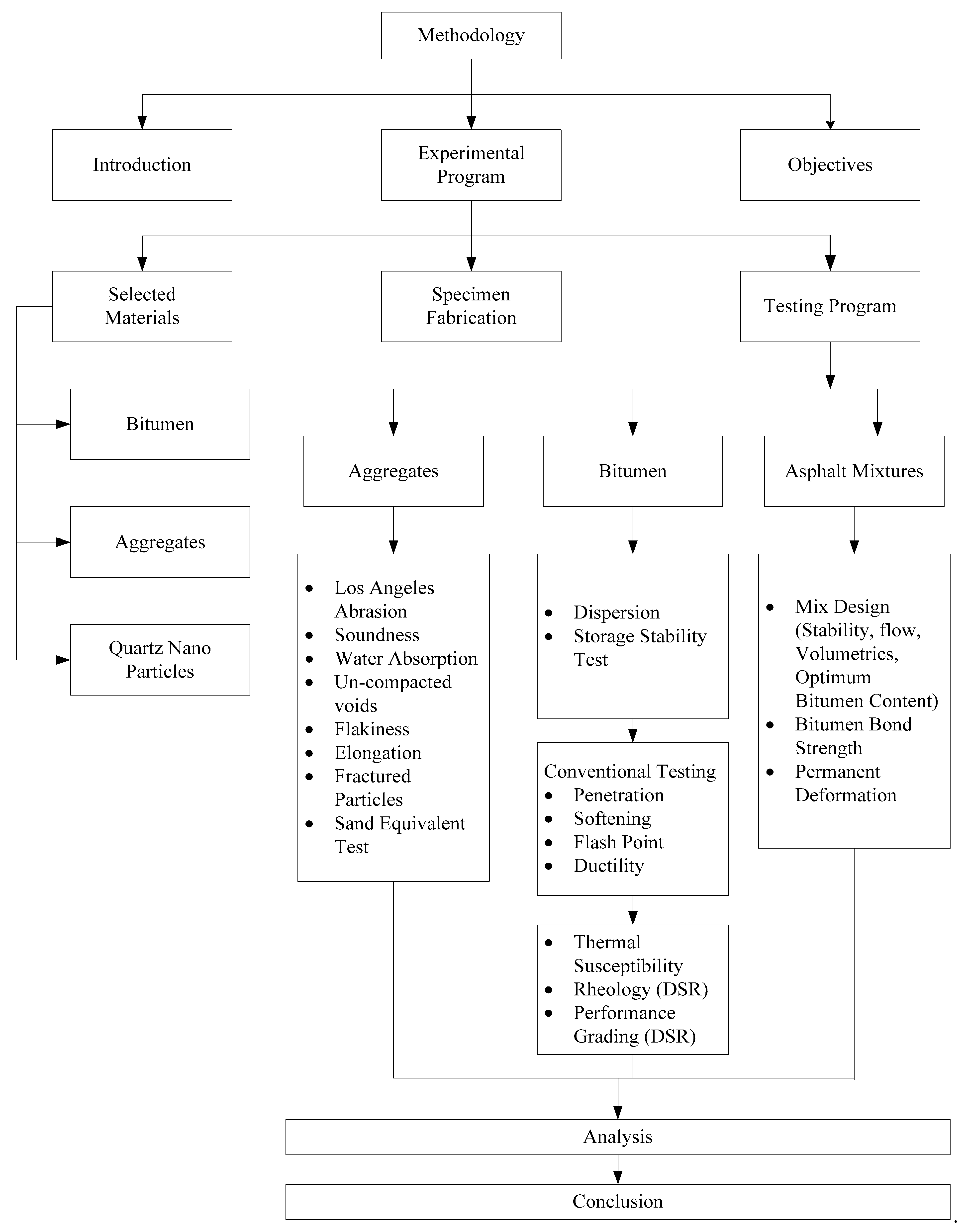
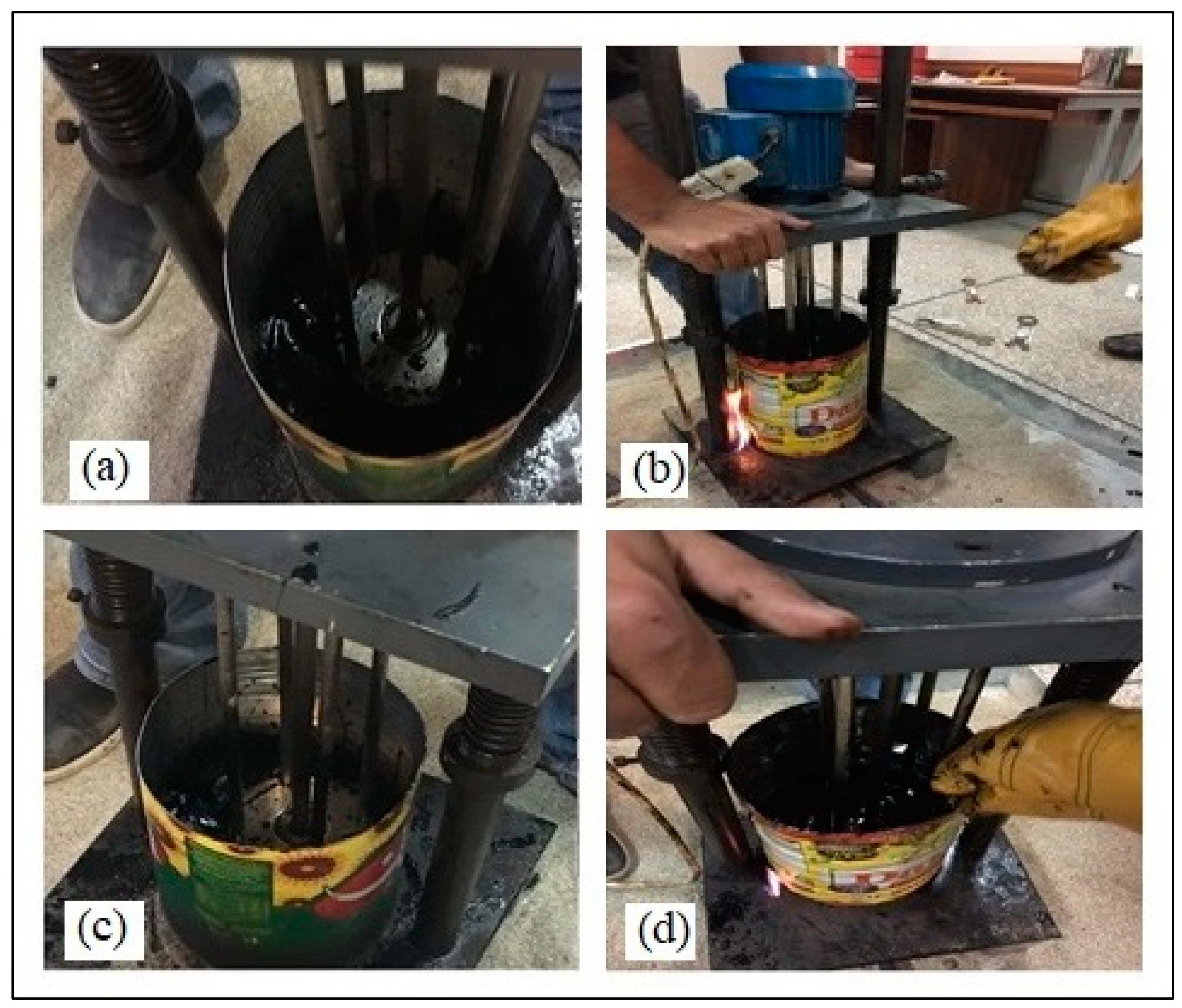

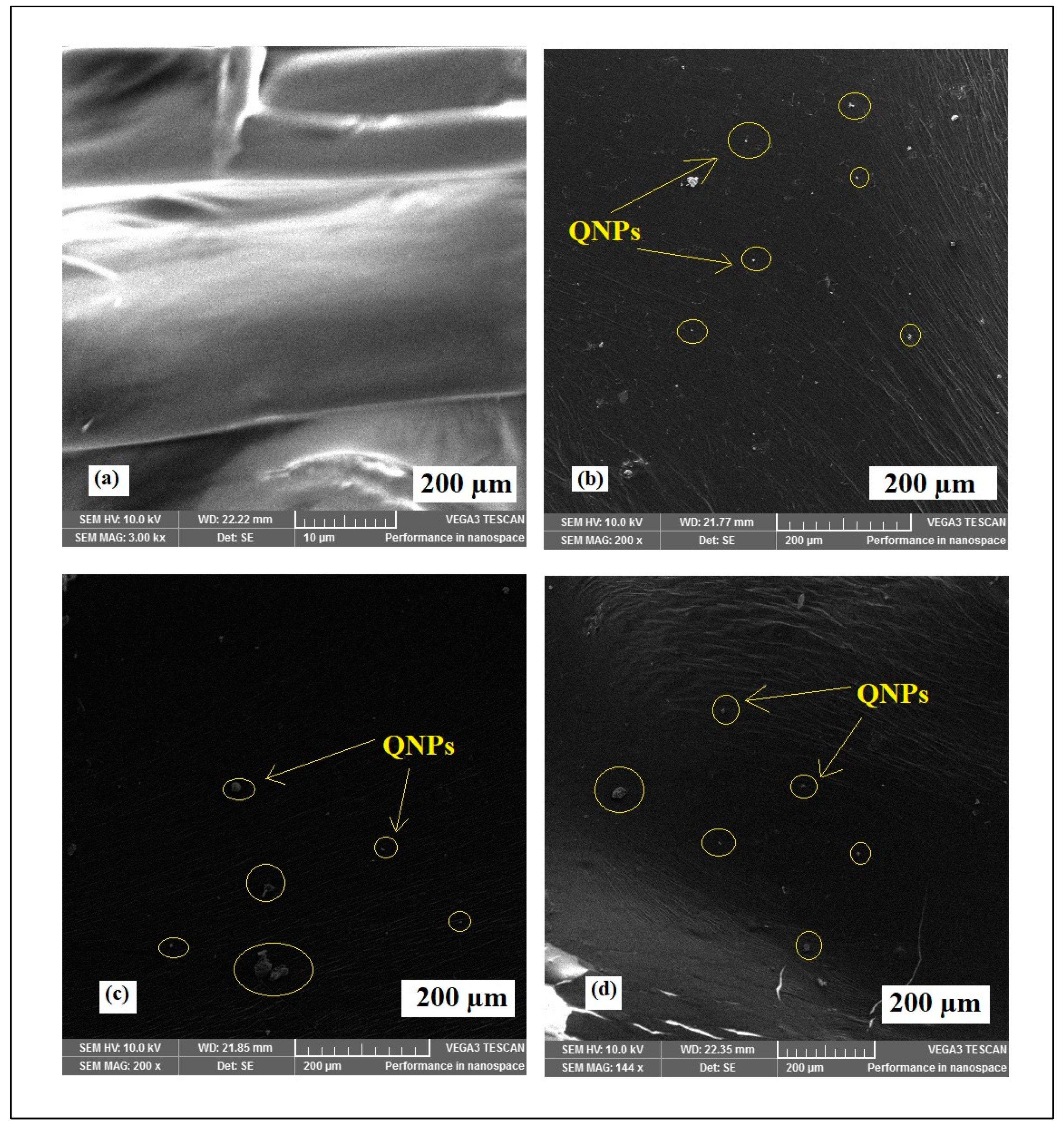
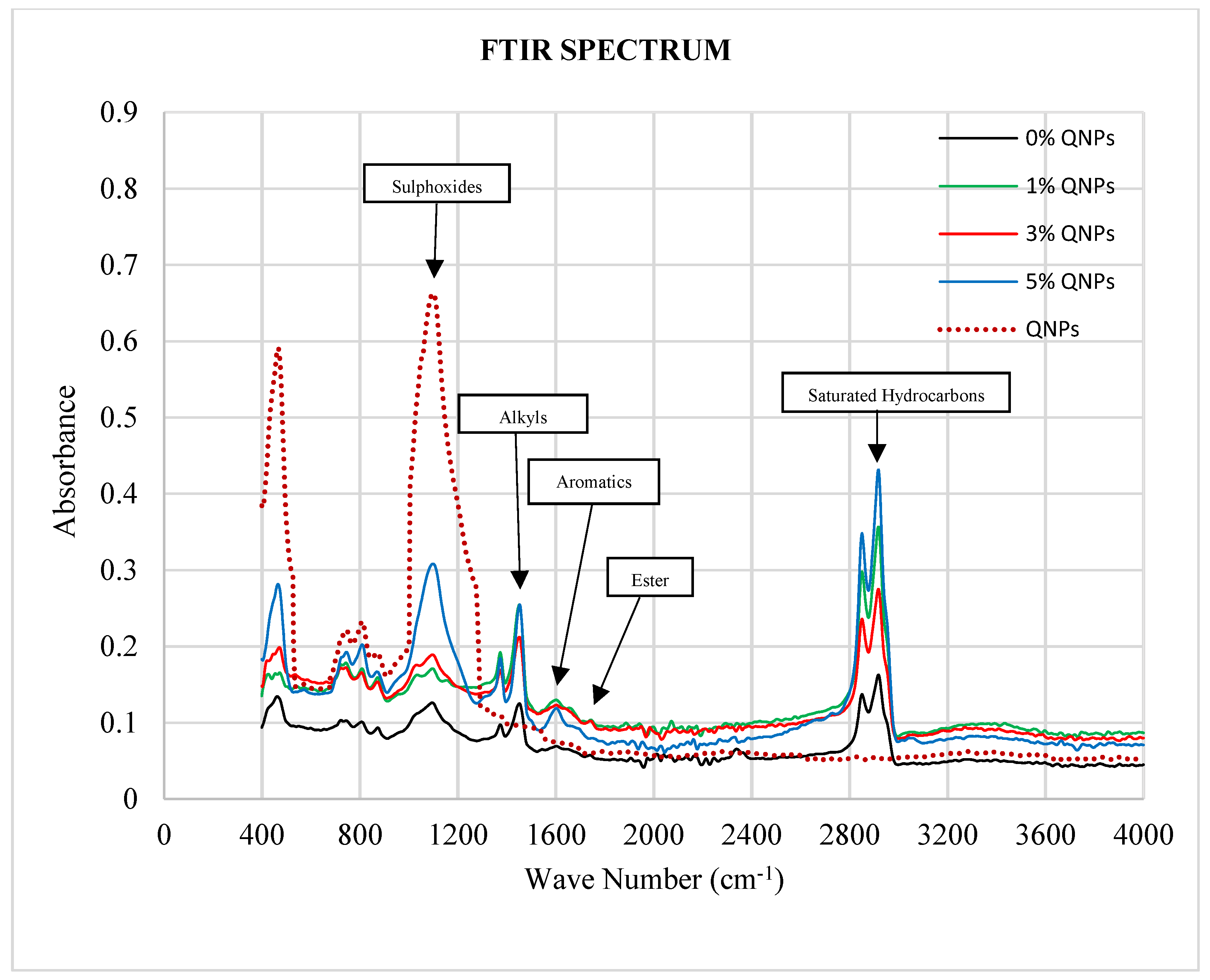
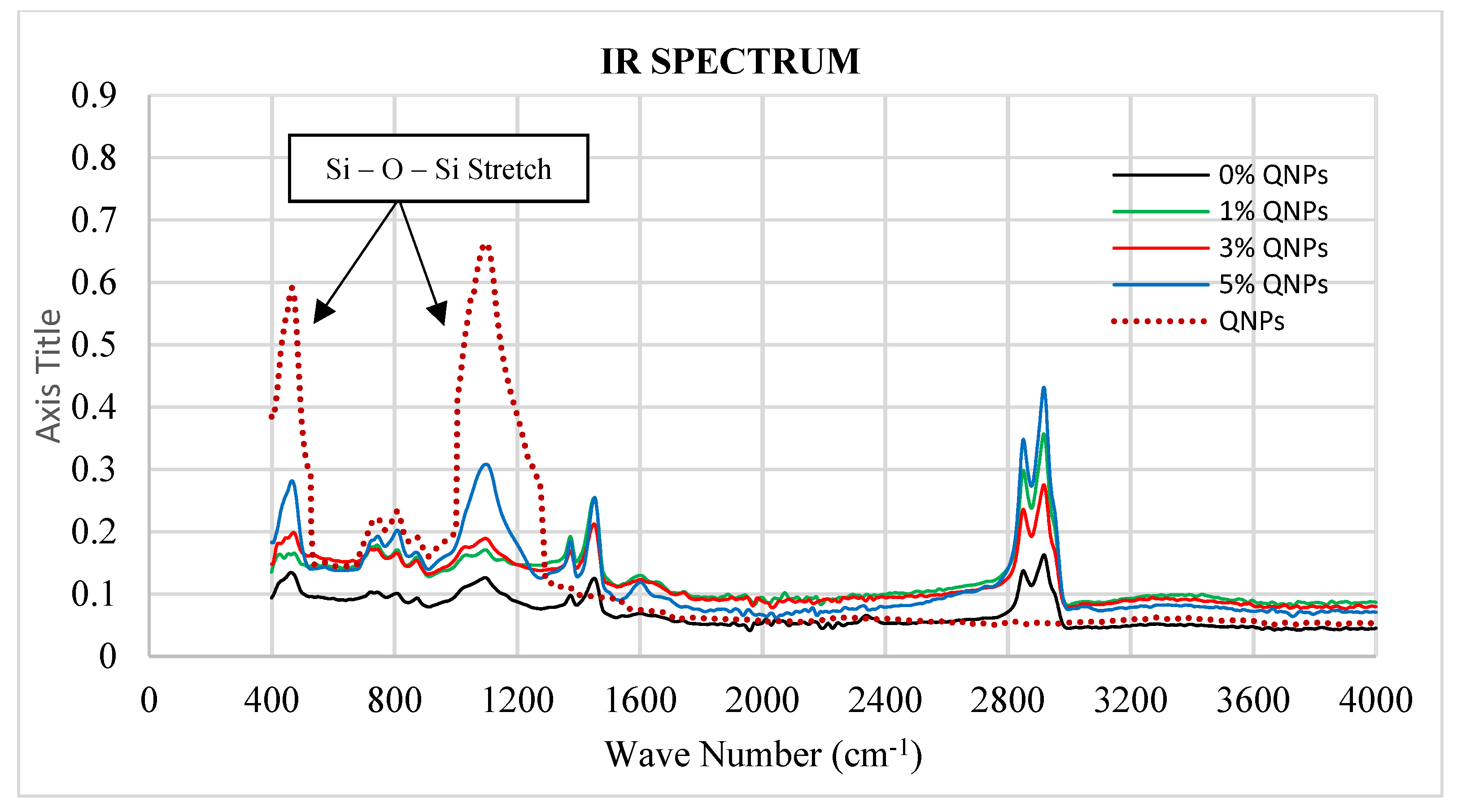

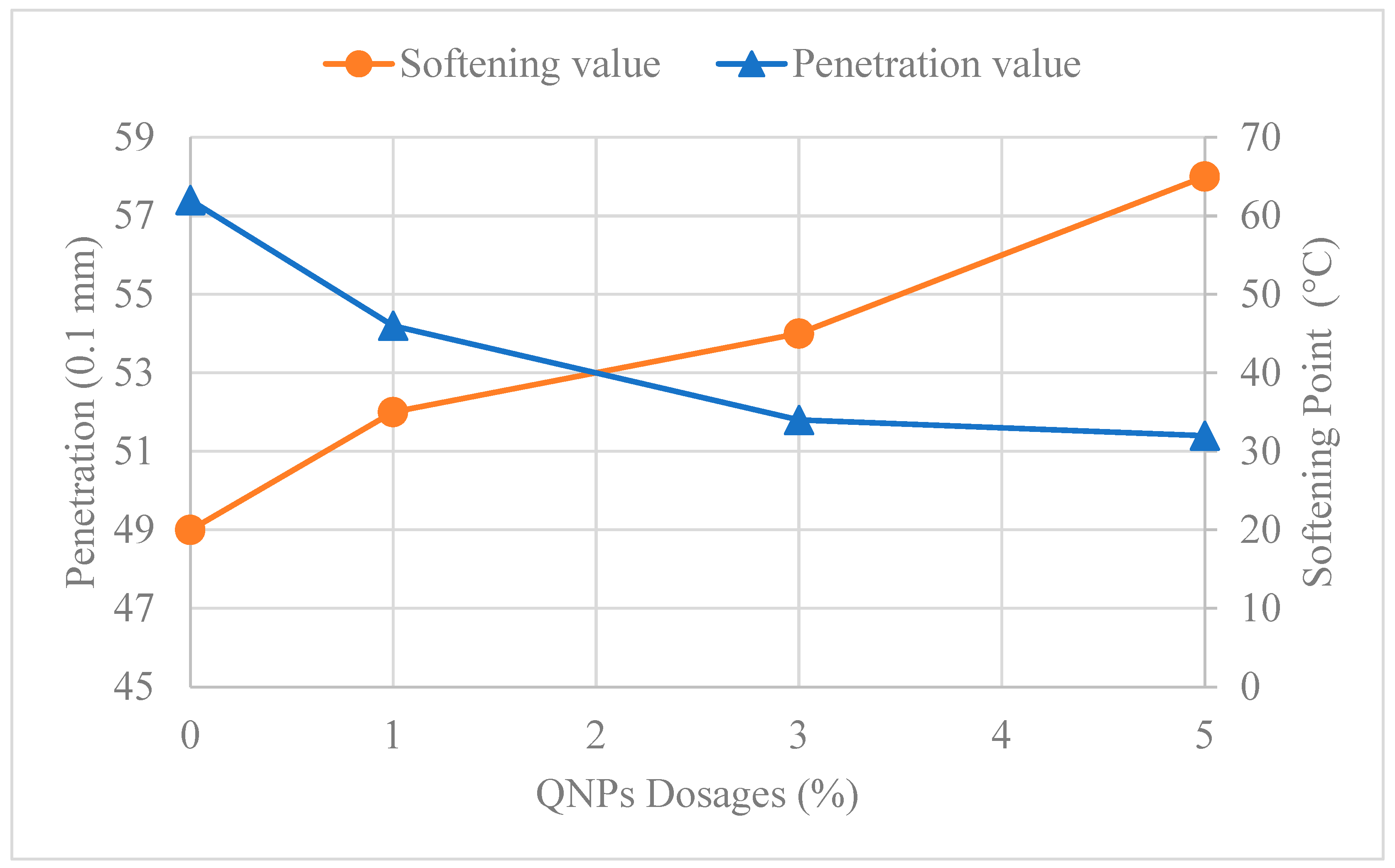



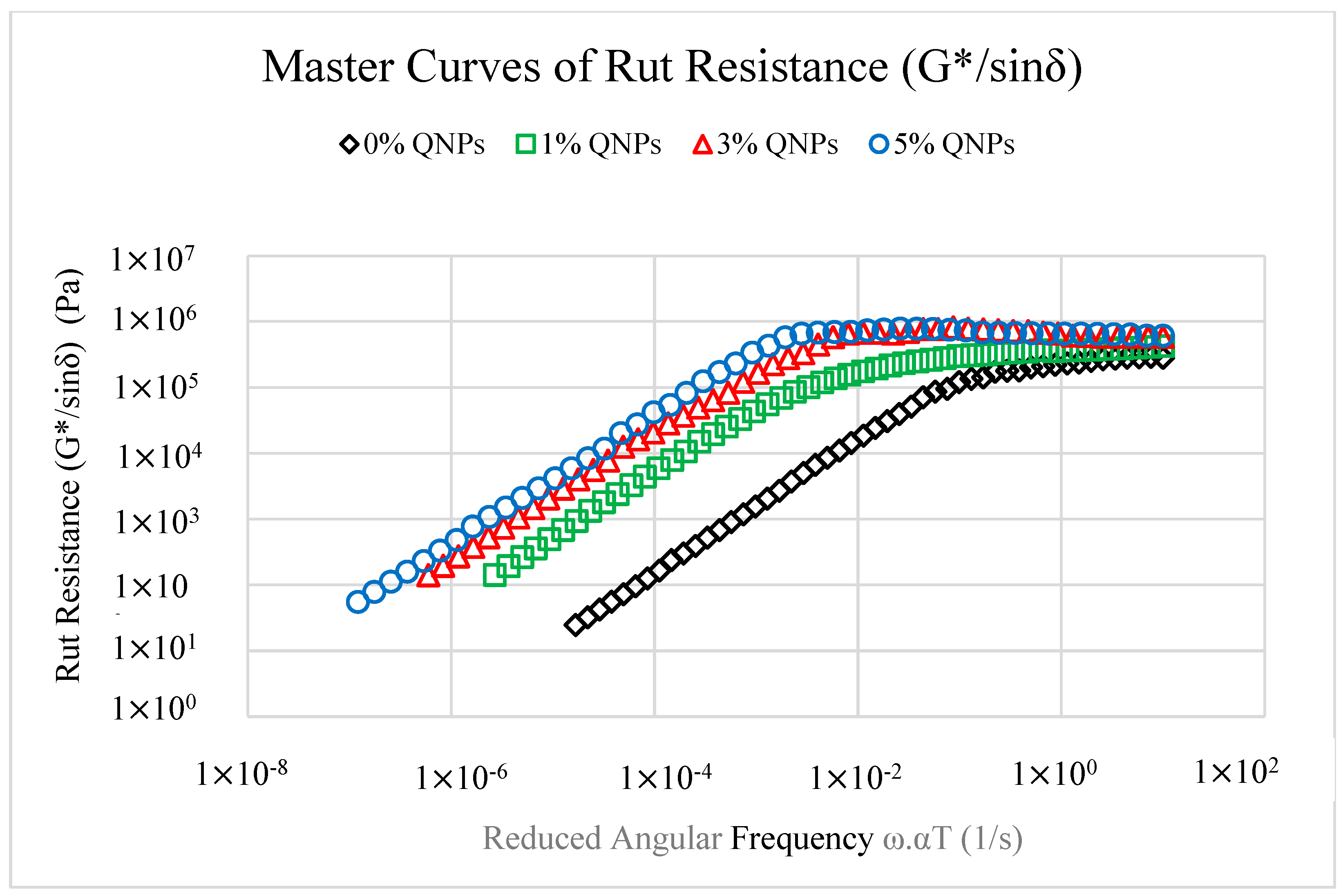
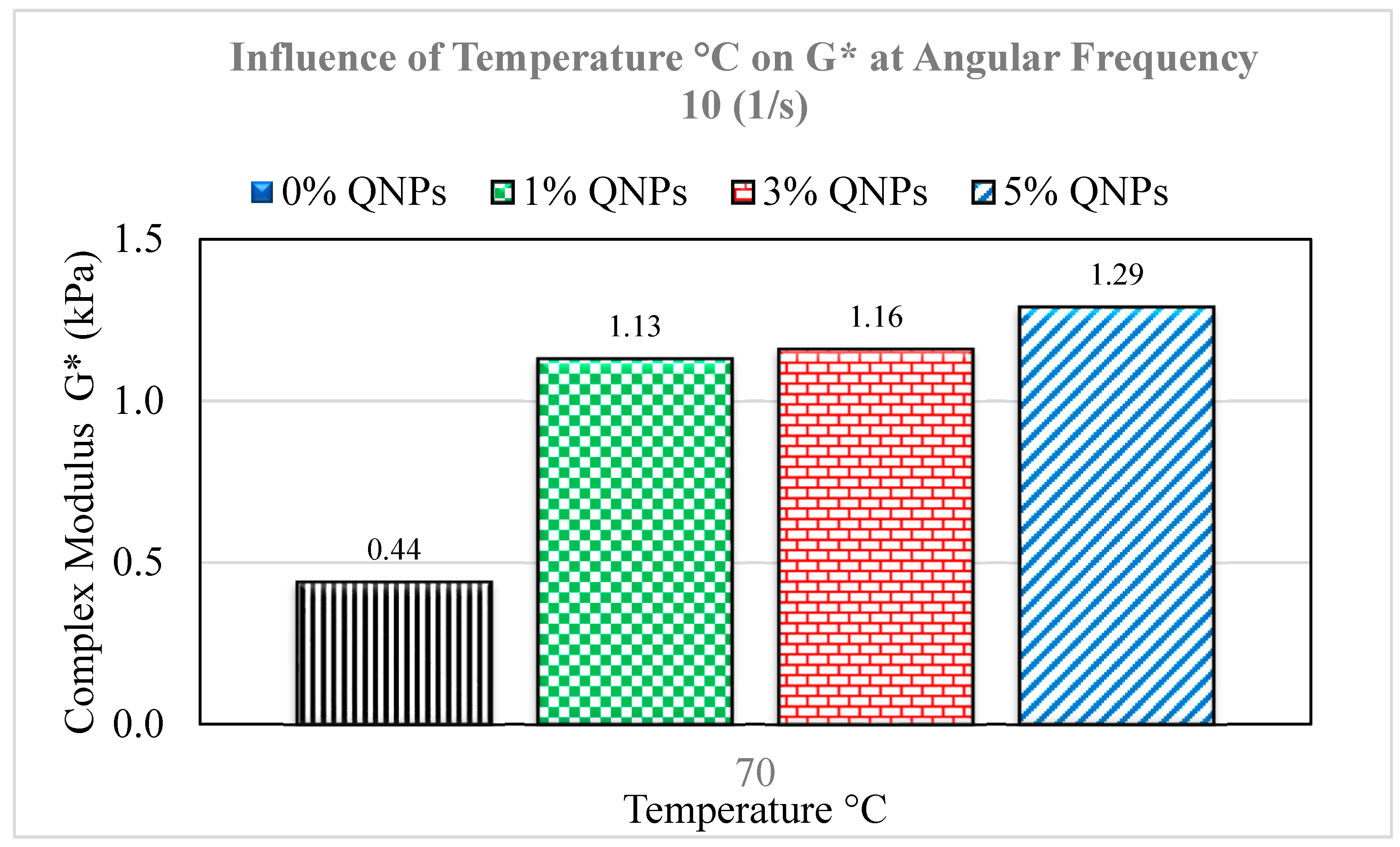

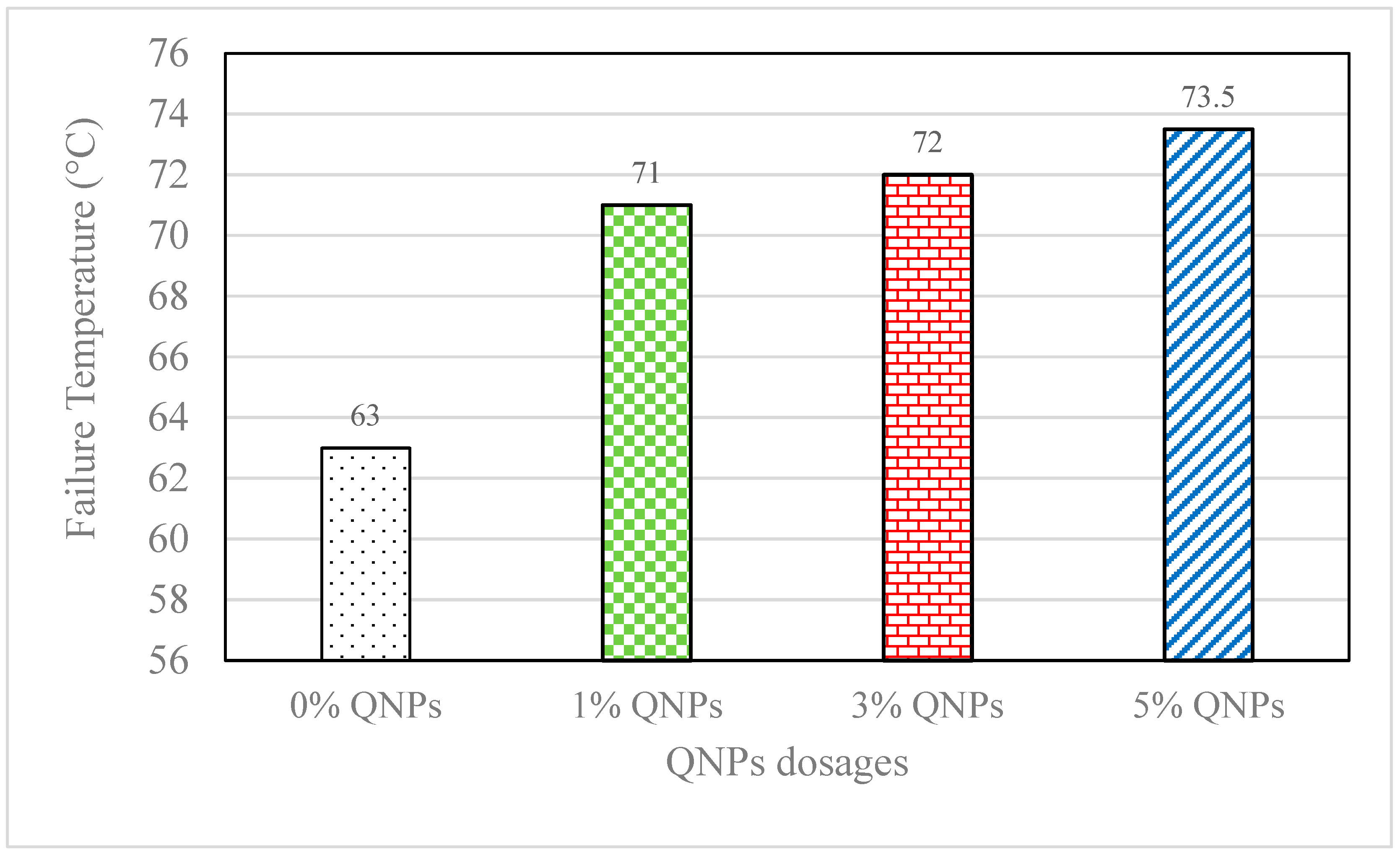
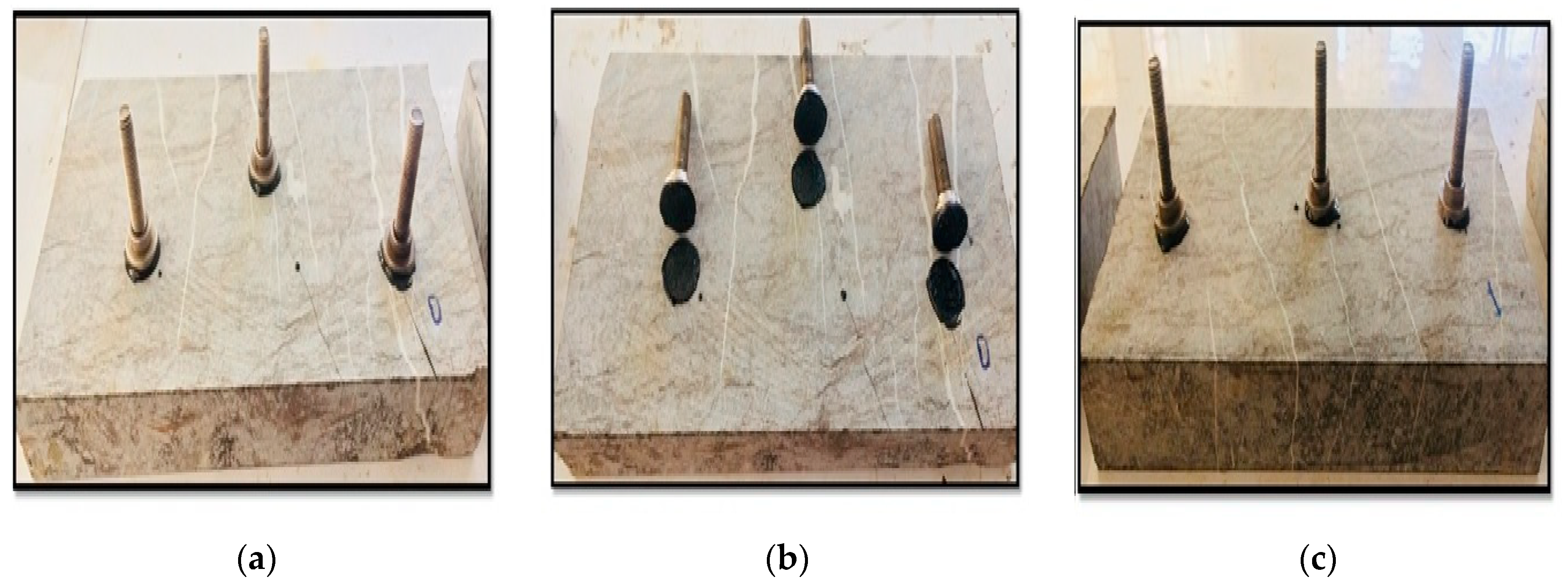
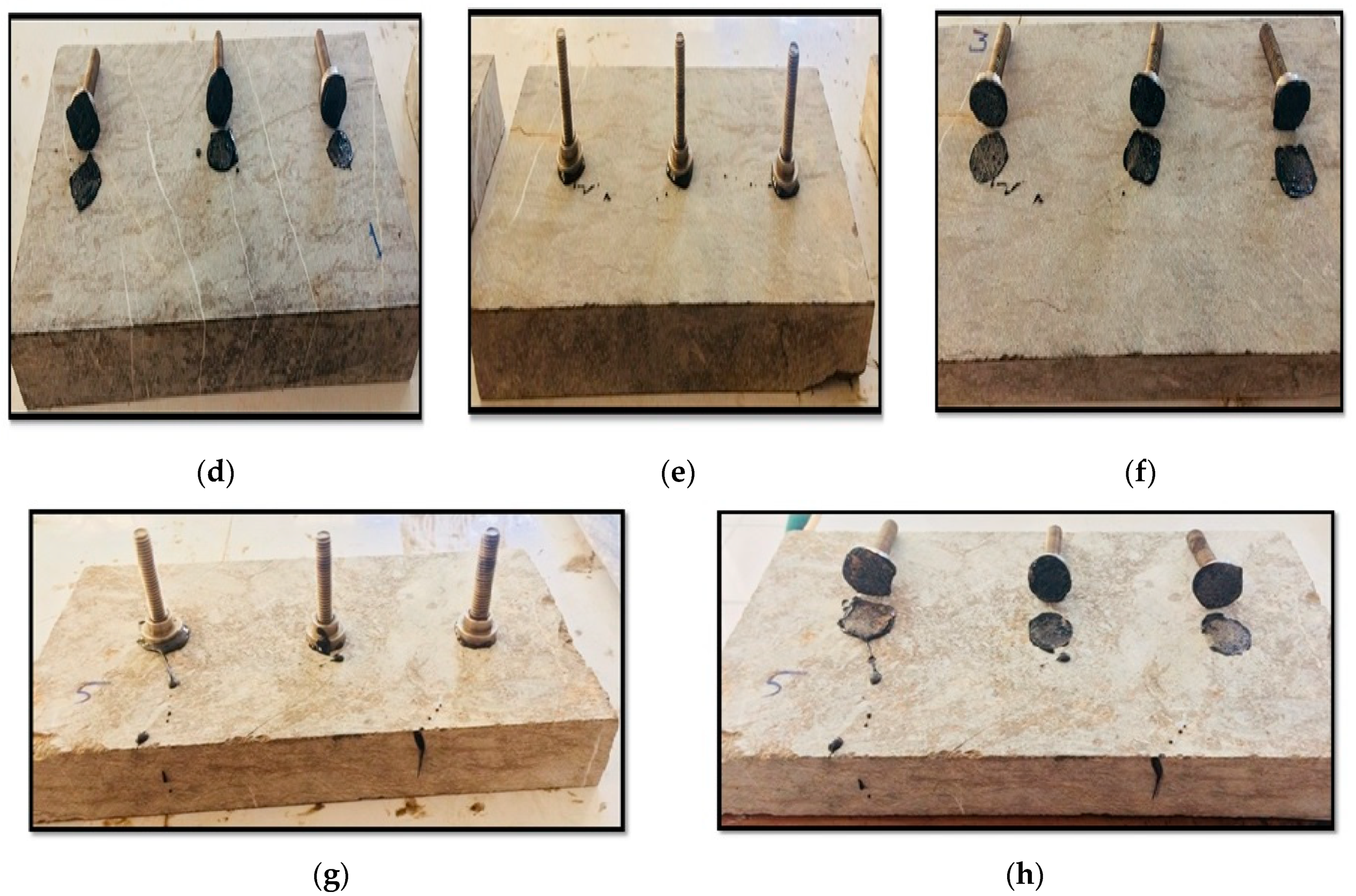


| Physical Properties | |
|---|---|
| Chemical formula | SiO2 |
| Molar mass | 60.08 gmol−1 |
| Melting point | >1600 °C |
| Boiling point | 2230 °C |
| Form | Nano-powder (Amorphous) |
| Surface Area | Spec. surface area 175–225 m2/g |
| Diameter | 12 nm |
| Bitumen | OBC % |
|---|---|
| PG 58-16 | 4.30 |
| 1% QNPs | 4.48 |
| 3% QNPs | 4.55 |
| 5% QNPs | 4.64 |
| Softening Point (°C) | Base Bitumen | QNP Content (%) | ||
|---|---|---|---|---|
| 1% | 3% | 5% | ||
| Top portion | 49.6 | 52 | 54 | 58 |
| Bottom portion | 50.0 | 52.9 | 55.1 | 59.4 |
| Difference | 0.4 | 0.9 | 1.1 | 1.4 |
| Tests | Base Bitumen | QNPs Modification (%) | ||
|---|---|---|---|---|
| 1 | 3 | 5 | ||
| Penetration (1/10 of mm) | 62 | 46 | 38 | 32 |
| Softening Point (°C) | 49 | 52 | 54 | 58 |
| Ductility (cm) | 109 | 76 | 58 | 40 |
| Flash Point (°C) | 242 | 249 | 261 | 269 |
| Fire Point (°C) | 247 | 253 | 265 | 273 |
| Penetration Index (PI) | −0.9474 | −0.9006 | −0.8580 | −0.3787 |
| Thermal Susceptibility (A) | 0.0463 | 0.0459 | 0.0456 | 0.0424 |
| Bitumen Grade | ARL Pen 60/70 |
|---|---|
| Bitumen Type | Base, 1% QNPS, 3% QNPS, and 5% QNPS |
| Test Temperature °C | 10 to 70 °C |
| Frequency Levels | 0.1 to 10 Hz |
| Strain Level | 12% (Base) |
| Output Parameters | G*, δ, G*/sin(δ) |
| No. of Samples | 4 (each 8 mm and 25 mm Diameter) |
| Mean Pts | Angular Frequency | Temperature | Complex Modulus G* | |||
| [kPa] | ||||||
| [1/s] | [°C] | 0% QNPS | 1% QNPS | 3% QNPS | 5% QNPS | |
| 1 | 10 | 10 | 1.80 × 1002 | 2.17 × 1002 | 3.51 × 1002 | 1.87 × 1002 |
| 2 | 10 | 20 | 1.94 × 1002 | 2.08 × 1002 | 1.54 × 1002 | 8.07 × 1002 |
| 3 | 10 | 30 | 1.45 × 1002 | 1.66 × 1002 | 5.10 × 1002 | 1.86 × 1002 |
| 4 | 10 | 40 | 4.14 × 1001 | 9.63 × 1001 | 1.01 × 1002 | 1.62 × 1002 |
| 5 | 10 | 50 | 3.51 × 1001 | 1.90 × 1001 | 2.32 × 1001 | 2.52 × 1001 |
| 6 | 10 | 60 | 2.07 × 1000 | 1.43 × 1000 | 4.88 × 1000 | 5.43 × 1000 |
| 7 | 10 | 70 | 4.36 × 10−01 | 1.13 × 1000 | 1.16 × 1000 | 1.29 × 1000 |
| Mean Pts | Angular Frequency | Temperature | G*/sin(delta) | |||
| [kPa] | ||||||
| [1/s] | [°C] | 0% QNPS | 1% QNPS | 3% QNPS | 5% QNPS | |
| 1 | 10 | 10 | 2.32 × 1002 | 3.31 × 1002 | 4.68 × 1002 | 2.07 × 1003 |
| 2 | 10 | 20 | 2.55 × 1002 | 3.20 × 1002 | 1.55 × 1002 | 9.07 × 1002 |
| 3 | 10 | 30 | 1.77 × 1002 | 2.34 × 1002 | 5.43 × 1002 | 2.03 × 1002 |
| 4 | 10 | 40 | 4.23 × 1001 | 1.05 × 1002 | 1.12 × 1002 | 1.70 × 1002 |
| 5 | 10 | 50 | 3.56 × 1001 | 1.95 × 1001 | 2.36 × 1001 | 2.58 × 1001 |
| 6 | 10 | 60 | 2.08 × 1000 | 1.46 × 1001 | 4.91 × 1000 | 5.47 × 1000 |
| 7 | 10 | 70 | 4.63 × 10-01 | 1.15 × 1000 | 1.19 × 1000 | 1.30 × 1000 |
| S. No | 24 h Dry Conditions (psi) | 24 h Wet Conditions (psi) | ||||||
|---|---|---|---|---|---|---|---|---|
| 0% | 1.0% | 3.0% | 5.0% | 0% | 1.0% | 3.0% | 5.0% | |
| 1 | 1279.1 | 1618.7 | 1924.3 | 2074.3 | 1130.8 | 1388.8 | 1560.1 | 1618.2 |
| (C) | (C) | (C/A) | (C/A) | (A) | (A) | (A) | (A) | |
| 2 | 1218.5 | 1601.9 | 1873.2 | 1983.9 | 1070.2 | 1469.0 | 1540.9 | 1611.8 |
| (C) | (C) | (C) | (C) | (A) | (A) | (C/A) | (C/A) | |
| 3 | 1283.2 | 1591.3 | 1773.1 | 1869.9 | 1086.9 | 1355.0 | 1662.3 | 1495.6 |
| (C) | (C) | (C) | (C) | (A) | (A) | (C/A) | (C/A) | |
| 4 | 1318.8 | 1612.4 | 1692.1 | 2001.1 | 1091.1 | 1557.6 | 1451.4 | 1695.7 |
| (C) | (C) | (C/A) | (C/A) | (A) | (A) | (A) | (C/A) | |
| 5 | 1270.7 | 1639.8 | 2052.2 | 2039.8 | 1078.5 | 1412.0 | 1564.3 | 1745.1 |
| (C) | (C) | (C) | (C) | (A) | (A) | (A) | (A) | |
| Average | 1274.1 | 1612.8 | 1863.0 | 1993.8 | 1091.5 | 1436.5 | 1555.8 | 1633.3 |
Publisher’s Note: MDPI stays neutral with regard to jurisdictional claims in published maps and institutional affiliations. |
© 2022 by the authors. Licensee MDPI, Basel, Switzerland. This article is an open access article distributed under the terms and conditions of the Creative Commons Attribution (CC BY) license (https://creativecommons.org/licenses/by/4.0/).
Share and Cite
Haroon, W.; Ahmad, N.; Mashaan, N. Effect of Quartz Nano-Particles on the Performance Characteristics of Asphalt Mixture. Infrastructures 2022, 7, 60. https://doi.org/10.3390/infrastructures7050060
Haroon W, Ahmad N, Mashaan N. Effect of Quartz Nano-Particles on the Performance Characteristics of Asphalt Mixture. Infrastructures. 2022; 7(5):60. https://doi.org/10.3390/infrastructures7050060
Chicago/Turabian StyleHaroon, Waqas, Naveed Ahmad, and Nuha Mashaan. 2022. "Effect of Quartz Nano-Particles on the Performance Characteristics of Asphalt Mixture" Infrastructures 7, no. 5: 60. https://doi.org/10.3390/infrastructures7050060








